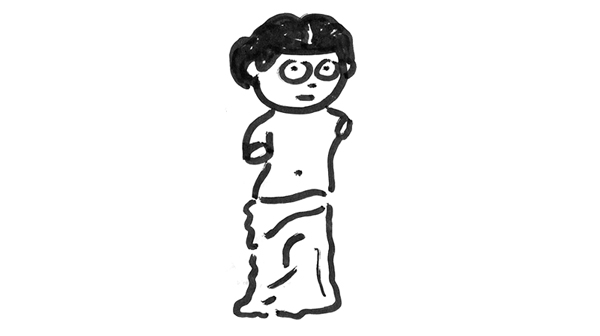Last week I came across the concept of Wabi-Sabi, and was immediately enthralled with the philosophy. It’s strikingly similar to many of the thoughts and beliefs I’ve been writing and drawing about for years. As I researched more, I realized the wabi-sabi philosophy pairs quite nicely with the creative process and artistic journey.
I’m sure my artistic journey started out pretty similarly to yours. I used to have so much anxiety over my artwork—my art never looked the way I wanted it to and was never as good as I wanted it to be. Even when I drew the best, most anatomically correct hand I had ever drawn, it still didn’t feel right. It was drawn well from a technical standpoint, but it didn’t feel like me. I was always focused on how I should be drawing or could be drawing, instead of how I was drawing.
It took me years of struggling before I realized that my natural style of art making is much more expressive and intuitive than what I was trying to achieve by forcing myself to draw the way I thought I should be drawing. Who knew that this was the beginning of me embracing the wabi-sabi philosophy and discovering how to make the art that felt like me?

The Wabi-Sabi Philosophy
Wabi-sabi emerged in 15th century Japan and embraces imperfection, impermanence, and the passing of time. Wabi loosely translates to simplicity, fulfillment, peace, and modesty. Sabi loosely translates to the acceptance and appreciation of the persistence of time.
Together, wabi-sabi is the understanding and acceptance of what is, and the appreciation of the impermanence of what is. Leonard Koren, author of the book Wabi-Sabi for Artists, Designers, Poets & Philosophers, defines it nicely:
“Wabi-sabi is a beauty of things imperfect, impermanent, and incomplete.
It is a beauty of things modest and humble.
It is a beauty of things unconventional.”
–Leonard Koren, artist + writer
Wabi-sabi appreciates the old, scruffy, and lopsided. It snubs the ideals of perfection, completion, and grandiosity. It prefers the simple, modest, and authentic. It believes nothing in life is finished, perfect, or permanent.
Wabi-sabi also accepts and appreciates the passing of time. It sees beauty in rusted barn roofs, tattered shoes, the pilled texture of a favorite coat, and a seasoned cast iron skillet passed down through generations.

Western Art Ideals
Much of the western world’s beliefs about beauty began with classical Greek art and is rooted in European ideals. The western world sees beauty in the decadence of the marble statue of Venus de Milo, the grandeur of the Sistine Chapel, and the perfection of the accurately rendered anatomical drawings of Leonardo Da Vinci. Western art strives for perfection, and buries flaws.
“The idea of wabi-sabi speaks of a readiness to accept things as they are. This is contrary to Western ideals that emphasize progress and growth as necessary components to daily living. Wabi-sabi’s fundamental nature is about process, not final product, about decay and aging, not growth. This concept requires the art of “slowness”, a willingness to concentrate on the things that are often overlooked, the imperfections and the marks recording the passing of time.”
–Richard Martin, photographer
The western art ideal pushes artists to aim for perfection, focus on progress and self-improvement, and prioritize finished products over process. It encourages us to draw things “correctly” and accurately.
However, those western views represent just one viewpoint.

Art the Wabi-Sabi Way
The wabi-sabi philosophy parallels the ongoing journey of an artist developing their artistic style. After years of struggling and trying to force an outcome with my art, I began exploring, playing, and experimenting in my sketchbook. I loosened up and allowed the process to take over. I stopped drawing everything in pencil first, painstakingly planning out a piece in detail, and I began letting my hand lead the way. I made a lot of terrible drawings full of mistakes and flaws. But I was opening up, accepting where I was in my artistic journey and learning to see my art for what it is, not what I want it to be.
“Wabi-sabi nurtures all that is authentic by acknowledging three simple realities: nothing lasts, nothing is finished and nothing is perfect.“
–Richard R. Powell, writer
And slowly, my “mistakes” started leading me down new and different paths. I began experimenting with ways of drawing I had never attempted, tools I had never used, and began developing a more free and playful mindset while drawing.

Creating art this way means there are no mistakes. There’s no wrong way to make your art. Taking up this philosophy freed me from the anxiety and worry that was stopping me from making the art that felt like me, and sometimes stopping me from making art at all.
“Nothing is a mistake. There’s no win and no fail, there’s only make.”
–Corita Scott Kent, artist + teacher
Making art the wabi-sabi way allows us to be more present in the process, letting our tools and materials be a part of where the art goes. It’s about seeing the process as more important than the finished piece of art. It’s about not trying to force a particular outcome.
Wabi-sabi doesn’t tell us what our artistic style is or where we’re going. It tells us to appreciate and see the beauty of where we are right now. It tells us not to obsess over the future when our art will be “better” or focus on the day we’ll finally be “successful”. Instead, we should appreciate where we are on the journey today, and appreciate the art we’re making today.
This state of mind is not about lack of ambition, laziness, or giving up on learning. It’s an acceptance and comfort with the journey, a patience with the process, and an appreciation for the present moment.

My Wabi-Sabi Art Philosophy
Here’s a short manifesto on how I believe the wabi-sabi mindset can be used in art making.
Cherish the process, not the final product.
Learn to love the process of art making and the process of discovering our artistic styles. The making is what matters most, not the final piece of art. Art is impermanent, but what we learn from making art will last forever.
Be patient and create modestly.
Forget illusions of fame, success, and wealth. Slow down on our quest to “find ourselves” or “become great artists”, and learn to love and appreciate our art for what it is, rather than constantly trying to perfect it.
Notice and embrace the imperfections in our art.
Be aware of and understand what comes to us naturally. Accept and appreciate ourselves as the artists we are today, including the imperfections and mistakes.
Appreciate where we are and enjoy the journey.
Don’t focus on the future. Value where we are right now at this moment. Aim to explore, and be the best we can, but appreciate where we are on our journey today.
Follow our intuition over rules and other people’s artistic ideals.
Develop a deep understanding of ourselves, and be compassionate towards ourselves and our art. Let our hands lead us, not what we’ve been told is the “correct” way to make art. Step back from the rational, formula-based drawing and into a more natural, intuitive form of art making.
Embrace and see the beauty in your sketchbook.
Celebrate our sketchbooks and embrace the transient, in-progress, unfinished work inside them. Our sketchbooks are always in a state of flux, always evolving and never complete, just like us, and just like our art.

Developing a Wabi-Sabi State of Mind
This wabi-sabi way of being and the search for our artistic styles are both lifelong journeys. In true wabi-sabi way, our artistic style can only be found through experience, deep understanding of ourselves, and the passing of time. The more of ourselves we can be aware of and appreciate, the more genuineness and authenticity we will have in our artwork.
Making art in a wabi-sabi way ultimately means learning to explore our artistic styles, enjoy where we are today on our artistic journeys, embrace mistakes, and trust the process. Accepting the imperfection and constant evolution of our art will free us from many of the anxieties that stop us from creating the art that feels like ours, or making art at all.
This way of being at peace with ourselves as artists and at peace with our art will only come to us through the process of art making.
We can only find ourselves and our art by doing the work.
“With my freckles & messy hair, bruised knees & chapped lips–this morning i am splendidly imperfect and alive. …another bath it will be!”
–Sabrina Ward Harrison, artist

